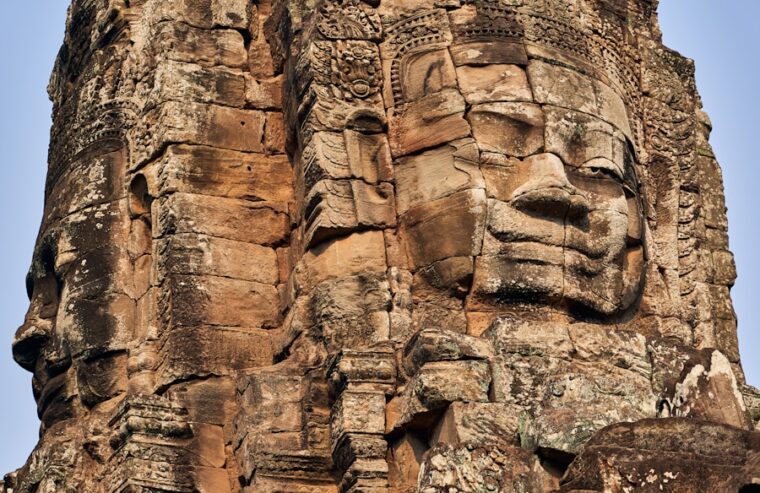Cambodia is a country with a rich and diverse history that dates back thousands of years. From the ancient Khmer Empire to the more recent colonial period, Cambodia has been shaped by a variety of influences that have left their mark on the country’s culture and traditions. The Khmer Empire, which ruled much of Southeast Asia from the 9th to the 15th centuries, left behind a legacy of stunning architecture, including the famous temples of Angkor Wat. The influence of Buddhism, which arrived in Cambodia around the 3rd century BCE, can be seen in the country’s art, architecture, and daily life. The more recent colonial period, during which Cambodia was ruled by France, also left its mark on the country, with French influence evident in the architecture and cuisine of Cambodia.
The culture of Cambodia is also deeply rooted in traditional practices and beliefs. The country’s rich tradition of dance, music, and art is a testament to the creativity and skill of its people. Traditional Khmer dance, with its graceful movements and intricate costumes, is a source of national pride and is often performed at important ceremonies and events. The people of Cambodia also have a strong sense of community and family, with traditional values such as respect for elders and hospitality playing an important role in daily life. Overall, Cambodia’s history and culture are a testament to the resilience and creativity of its people, and exploring these aspects of the country is an essential part of any visit to Cambodia.
Exploring the Ancient Temples of Angkor Wat
One of the most iconic symbols of Cambodia is the ancient temple complex of Angkor Wat. Built in the 12th century by the Khmer Empire, Angkor Wat is the largest religious monument in the world and a UNESCO World Heritage site. The temple complex is a stunning example of Khmer architecture and is renowned for its intricate carvings, towering spires, and serene courtyards. Exploring Angkor Wat is a truly awe-inspiring experience, as visitors can wander through the ancient ruins and marvel at the skill and craftsmanship of the Khmer builders. The temple complex is also surrounded by a lush jungle, adding to its sense of mystery and grandeur.
In addition to Angkor Wat, there are many other temples to explore in the area, each with its own unique history and architectural style. The Bayon Temple, with its famous stone faces, and the Ta Prohm Temple, which is being slowly reclaimed by the jungle, are just two examples of the many fascinating sites to visit in the Angkor Archaeological Park. Exploring these ancient temples offers visitors a glimpse into Cambodia’s rich history and provides a deeper understanding of the country’s cultural heritage. Whether you’re an architecture enthusiast, a history buff, or simply someone who appreciates natural beauty, a visit to Angkor Wat is an essential part of any trip to Cambodia.
The Natural Beauty of Cambodia: From Stunning Beaches to Lush Jungles
Cambodia is a country of incredible natural beauty, with diverse landscapes that range from pristine beaches to lush jungles. The country’s coastline is dotted with beautiful beaches and islands, offering visitors the chance to relax on white sandy shores and swim in crystal-clear waters. Popular beach destinations such as Sihanoukville and Koh Rong are known for their laid-back atmosphere and stunning sunsets, making them perfect for a relaxing beach getaway. For those who prefer adventure, Cambodia’s jungles offer plenty of opportunities for hiking, wildlife spotting, and exploring ancient ruins hidden in the dense foliage.
In addition to its beaches and jungles, Cambodia is also home to several stunning natural attractions, including waterfalls, lakes, and national parks. The Tonle Sap Lake, the largest freshwater lake in Southeast Asia, is a vital ecosystem that supports a diverse array of wildlife and provides a livelihood for many Cambodians. The Cardamom Mountains, located in the southwest of the country, are home to dense rainforests, rare wildlife species, and remote indigenous communities. Exploring these natural wonders allows visitors to connect with Cambodia’s environment and gain a deeper appreciation for the country’s natural heritage. Whether you’re a beach lover, a nature enthusiast, or simply someone who enjoys breathtaking scenery, Cambodia has something to offer everyone.
Sampling the Delicious Cuisine of Cambodia
Cambodian cuisine is a delicious blend of flavors and influences that reflects the country’s diverse cultural heritage. The cuisine is characterized by fresh ingredients, aromatic herbs and spices, and a focus on balance and harmony in flavors. Rice is a staple food in Cambodia and is often served alongside a variety of dishes such as soups, curries, stir-fries, and grilled meats. Fish is also a common ingredient in Cambodian cuisine, thanks to the country’s abundant rivers and lakes.
One of the most famous Cambodian dishes is amok, a creamy curry made with fish or chicken and flavored with coconut milk and aromatic spices. Another popular dish is bai sach chrouk, which consists of grilled pork served with rice and pickled vegetables. Street food is also an important part of Cambodian culinary culture, with vendors selling everything from noodle soups to grilled meats to sweet treats such as sticky rice desserts. In addition to traditional Cambodian dishes, the country’s cuisine has also been influenced by neighboring countries such as Thailand and Vietnam, resulting in a diverse array of flavors and dishes to sample. Whether you’re dining at a local market stall or a high-end restaurant, sampling the delicious cuisine of Cambodia is an essential part of any visit to the country.
Getting to Know the Warm and Friendly People of Cambodia
One of the most memorable aspects of visiting Cambodia is getting to know its warm and friendly people. Cambodians are known for their hospitality and generosity, and visitors to the country are often struck by the genuine warmth and kindness of the locals. Whether you’re exploring a bustling market in Phnom Penh or visiting a remote village in the countryside, you’re likely to be greeted with smiles and open arms by the people you meet. Cambodians are also known for their strong sense of community and family, with traditional values such as respect for elders and helping others playing an important role in daily life.
In addition to their warmth and hospitality, Cambodians are also known for their resilience in the face of adversity. The country has faced its share of challenges over the years, including war, political instability, and natural disasters, yet the people have remained strong and hopeful. Visitors to Cambodia often find inspiration in the stories of individuals who have overcome hardship and are working to build a better future for themselves and their communities. Getting to know the warm and friendly people of Cambodia offers visitors a deeper understanding of the country’s culture and traditions and provides an opportunity to connect with individuals who embody the spirit of resilience and hope.
Exploring the Bustling Markets and Vibrant Cities of Cambodia
Cambodia’s cities are vibrant hubs of activity that offer visitors a fascinating mix of modern amenities and traditional charm. The capital city of Phnom Penh is a bustling metropolis that is home to a rich array of cultural attractions, including historic temples, museums, and art galleries. The city’s vibrant markets are also a must-visit for anyone looking to experience Cambodia’s lively street life and sample local cuisine. From colorful produce markets to bustling night markets selling everything from clothing to handicrafts to street food, Phnom Penh’s markets are a feast for the senses.
In addition to Phnom Penh, Cambodia is home to several other vibrant cities that offer unique experiences for visitors. Siem Reap, located near the famous temples of Angkor Wat, is a popular tourist destination known for its lively nightlife, art galleries, and traditional dance performances. Battambang, Cambodia’s second-largest city, is renowned for its well-preserved colonial architecture and thriving arts scene. Exploring these bustling cities allows visitors to immerse themselves in Cambodia’s urban culture while also providing opportunities to connect with locals and learn about daily life in modern-day Cambodia.
Responsible Travel in Cambodia: Supporting Local Communities and Protecting the Environment
As tourism continues to grow in Cambodia, it’s important for visitors to consider how they can travel responsibly and support local communities while minimizing their impact on the environment. There are many ways that travelers can contribute positively to Cambodia’s development while also enjoying their visit to the country. One way to support local communities is by choosing accommodations that are owned by Cambodians or employ local staff members. This helps ensure that tourism dollars stay within the community and provide economic opportunities for local residents.
Another way to travel responsibly in Cambodia is by supporting local businesses such as restaurants, markets, and tour operators that prioritize sustainability and ethical practices. By choosing eco-friendly tours that promote conservation efforts or purchasing handicrafts made by local artisans, visitors can contribute directly to initiatives that protect Cambodia’s natural resources and cultural heritage. Additionally, travelers can minimize their environmental impact by practicing responsible waste management, conserving water and energy, and respecting wildlife habitats during their visit.
Finally, responsible travel in Cambodia also involves being mindful of cultural norms and traditions while interacting with local communities. By learning about Cambodian customs and etiquette before visiting the country, travelers can show respect for local traditions while also fostering positive cross-cultural exchanges. Ultimately, responsible travel in Cambodia benefits both visitors and locals by promoting sustainable development while preserving the country’s unique culture and environment.
In conclusion, Cambodia offers visitors a wealth of experiences that encompass its rich history and culture, stunning natural beauty, delicious cuisine, warm and friendly people, vibrant cities, and opportunities for responsible travel. Whether you’re exploring ancient temples at Angkor Wat or relaxing on pristine beaches along the coast, there’s something for everyone in this diverse and captivating country. By immersing yourself in Cambodia’s culture and traditions while also supporting local communities and protecting the environment, you can make your visit to this extraordinary country both meaningful and memorable.


